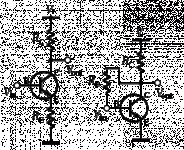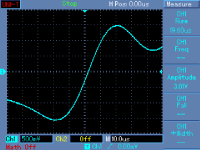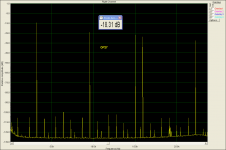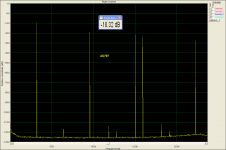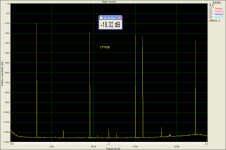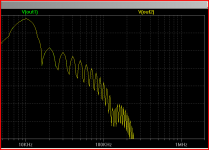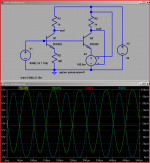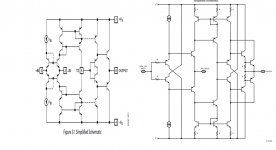PMA, it would be better that you used the guideline stated by Otala if you are going to make a comparison between what he got and EXACTLY what you are getting. You don't appear to be paying any attention to the original test that I felt was 'interesting'. Your voltage gain is off, your bandwidth limitation is off, and you are using a different part. What would you expect to 'compare' to the original work?
Hi,
Let me first say that reading the last page I am feeling like it is the day of the bewilderbeast. Gentelmen, YOU HAVE GOT TO BE KIDDING!
As for the challenge, see attached. Would anyone like to assert the equivalency of these two circuits given the same amount of feedback?
Ciao T
care to point to a circuit that shows the difference between degeneration, negative feedback that you're asserting?
Let me first say that reading the last page I am feeling like it is the day of the bewilderbeast. Gentelmen, YOU HAVE GOT TO BE KIDDING!
As for the challenge, see attached. Would anyone like to assert the equivalency of these two circuits given the same amount of feedback?
Ciao T
Attachments
Hi,
The usual way?
See EE201 approximatly (at least when I studied).
It's covered in Horrowitz and Hill.
Ciao T
How do you propose we analytically deal with these circuits.
The usual way?
See EE201 approximatly (at least when I studied).
It's covered in Horrowitz and Hill.
Ciao T
your bandwidth limitation is off
It is bandlimited at 24kHz.
I am sure I can get enough information, for the reason that I have much higher dynamic range in the FFT analysis, compared to the original paper. The question is if the efforts would bring any new and usable information and insight.
Attachments
Last edited:
AD797 gives very good results, and LT1122 is the best from several opamps I tested, regarding TIM. Slew rate matters, even for bandwidth limited (24kHz) DIM test.
This method seems to be a useful additional test method to standard THD, SMPTE and CCIF tests.
This method seems to be a useful additional test method to standard THD, SMPTE and CCIF tests.
Attachments
I think it would be very helpful in these discussions if people could specify
whether they are referring to "local loop" or degeneration or what mix
when they talk about local feedback.
Degeneration and loop feedback are not the same thing, one of the issues
I have with Bruno's article, as he has made statements that imply that
they are.

I am eagerly awaiting a Letter to the Editor
jan
Hi,
Quel dommage! You mean the AD797's performance is SID/TIM limited?
Did you try a modern current feedback video Op-Amp?
Ciao T
AD797 gives very good results, and LT1122 is the best from several opamps I tested, regarding TIM. Slew rate matters, even for bandwidth limited (24kHz) DIM test.
Quel dommage! You mean the AD797's performance is SID/TIM limited?
Did you try a modern current feedback video Op-Amp?
Ciao T
Scott,
Have we found another area to disagree?
If I take two gain stages and apply global feedback, and compare that to the same two stages each with local feedback for the same gain and compare that to two stages with partial local feedback and overall global feedback to the same gain, you support that all of these will have the same final distortion spectra?
In B.P.s article he allows as his error may be a complex function and then shows it as a single term added in at the end of the network. That is true but it is more enlightening if there is an error term added in at each stage. That way you see the e^2 or ^3....
ES
You again are putting words in my mouth, I never said the same. In fact if you apply the JC-3 trick to the AD844 the distortion is WORSE. That is inverting gain of ~10 with the Tz node used for local feedback to the inverting input. This is freshman year stuff. The major source of distortion (the tanh function of the output diamond) is inside the global loop but not the local one. Less global feedback more distortion. DUH!
BTW if you load the Tz to ground it is also worse.
What Cherry does is show you how to ADD gain stages and still make things stable. As the two series opamps with VERY high OLG and an initial 40db/dec roll off.
Last edited:
Hi,
Quel dommage! You mean the AD797's performance is SID/TIM limited?
Did you try a modern current feedback video Op-Amp?
Ciao T
Hi Thorsten,
no, I do not think so. It behaves very well, and both AD797 and LT1122 measurements are close to the limit of my method/instruments.
Regarding "SID/TIM limited" term, it is always a question of a "measure", how close we are to component's slew rate. And, it is not easy to distinguish between influence of slew rate and common "static" non-linearity.
Regards,
Did you try a modern current feedback video Op-Amp?
Ciao T
Lots of noise, DC errors, bias current offset/noise, 1KHz distortion low but no match for many amps. There's a lot more applications than audio.
Bipolar vs FET with 3X the slew rate and the difference is small. Yes PMA put a modern CF video amp in your test fixture, to be fair let Thorsten pick one.
Last edited:
Hi,
Now who is building strawmen?
The AD844's "single stage" current feeedback design means that not only does it have rather low opan-loop gain (can't be bothered to calculate it) but I suspect that the output stage is pretty resolutely "class B".
How about a more conventional topology?
Ciao T
In fact if you apply the JC-3 trick to the AD844 the distortion is WORSE. That is inverting gain of ~10 with the Tz node used for local feedback to the inverting input. This is freshman year stuff. The major source of distortion (the tanh function of the output diamond) is inside the global loop but not the local one. Less global feedback more distortion. DUH!
BTW if you load the Tz to ground it is also worse.
Now who is building strawmen?
The AD844's "single stage" current feeedback design means that not only does it have rather low opan-loop gain (can't be bothered to calculate it) but I suspect that the output stage is pretty resolutely "class B".
How about a more conventional topology?
Ciao T
Hi Scott,
I am not sure you are particularly accurate. While relatively speaking the values are a bit greater than the best conventional Op-Amp's, however into Audio Type Loads (10K and 600 Ohm) and across the audio range distrtion is typically quite low (0.001% is common).
Voltage noise is often quite low (<< NE5532 levels), DC precision and input bias etc is a possible issue, but trivial to address and generally not critical in Audio (other than input current noise).
I'll pick Analog Devices AD815 as first choice, Nat Semi LM6181 as second if the oddball AD815 pinout gives trouble. Beware, both a bit dodgy re. stability without extra measures over generic op-amp's.
Incidentally, the AD815 can make a swell line stage, as Carlos used to show...
Ciao T
Lots of noise, DC errors, bias current offset/noise, 1KHz distortion low but no match for many amps.
I am not sure you are particularly accurate. While relatively speaking the values are a bit greater than the best conventional Op-Amp's, however into Audio Type Loads (10K and 600 Ohm) and across the audio range distrtion is typically quite low (0.001% is common).
Voltage noise is often quite low (<< NE5532 levels), DC precision and input bias etc is a possible issue, but trivial to address and generally not critical in Audio (other than input current noise).
Yes PMA put a modern CF video amp in your test fixture, to be fair let Thorsten pick one.
I'll pick Analog Devices AD815 as first choice, Nat Semi LM6181 as second if the oddball AD815 pinout gives trouble. Beware, both a bit dodgy re. stability without extra measures over generic op-amp's.
Incidentally, the AD815 can make a swell line stage, as Carlos used to show...
Ciao T
Hi,
Now who is building strawmen?
Ciao T
Charle's Hansen for one. Actually the gain is rather high, several thousand, probably higher than the JC-3 with the vintage devices and no cascode at the high Z node. The AD815 is not matierially different nor are any one of the other basic CFA's. We needed the DSL business to light a fire under the designer's seats. And please don't obscure the point, the output stage induced distortion is WORSE no matter where it starts.
Last edited:
Thorsten's NOT equivalent circuits are a Strawman
I see Thorsten either failed feedback 202 himself or just holds us in such contempt that he feels he can toss up just anything and assert it means he’s right, everyone else is a fool
http://www.diyaudio.com/forums/anal...urls-blowtorch-preamplifier-part-ii-1579.html
I specifically mentioned, linked to the series-shunt classification of feedback - Marshall Leach feedback course lecture notes/supplement
Thorsten’s (not equivalent) circuits, comment implying that feedback theory would mean they were the same shows he doesn’t understand its application or thinks no one will call him on it
The sim below shows a equivalent feedback formulation of the CE gain stage with “output current sampling” – using a spice E dependent source to transfer/scale the collector R voltage to the emitter of Q2
this is "the proper" way to create an equivalent to the CE V gain amp, and addresses Nelson's claim that degeneration has inherently different properties
You only see two traces because the other two colors are over written by the same waveform from the two versions of the circuit
the overlaid Q1,2 I_b plots show that input Z is the same, out1,2 also completely over lie each other
The fft plot shows identical distortion spectrum
Correctly understand the feedback classification system, apply it consistently, and the results really do work, we can show emitter degeneration R gives the same result as “output feedback” in the CE amp at frequencies where the loop gain is large
I see Thorsten either failed feedback 202 himself or just holds us in such contempt that he feels he can toss up just anything and assert it means he’s right, everyone else is a fool
http://www.diyaudio.com/forums/anal...urls-blowtorch-preamplifier-part-ii-1579.html
I specifically mentioned, linked to the series-shunt classification of feedback - Marshall Leach feedback course lecture notes/supplement
Thorsten’s (not equivalent) circuits, comment implying that feedback theory would mean they were the same shows he doesn’t understand its application or thinks no one will call him on it
The sim below shows a equivalent feedback formulation of the CE gain stage with “output current sampling” – using a spice E dependent source to transfer/scale the collector R voltage to the emitter of Q2
this is "the proper" way to create an equivalent to the CE V gain amp, and addresses Nelson's claim that degeneration has inherently different properties
You only see two traces because the other two colors are over written by the same waveform from the two versions of the circuit
the overlaid Q1,2 I_b plots show that input Z is the same, out1,2 also completely over lie each other
The fft plot shows identical distortion spectrum
Correctly understand the feedback classification system, apply it consistently, and the results really do work, we can show emitter degeneration R gives the same result as “output feedback” in the CE amp at frequencies where the loop gain is large
Attachments
Last edited:
The AD844's "single stage" current feeedback design means that not only does it have rather low opan-loop gain (can't be bothered to calculate it).
How about a more conventional topology?
Ciao T
OK folks AM I wasting my time? If we can't agree on what topology means it's going to be rough. HINT: the diode vs follower input devices is a trivial difference (offset considerations). AD844 vs. the LM amp just mentioned.
These are simplified, the AD844 has degeneration resistors and short circuit current limit not shown (making the two schematics even more the same).
Attachments
Last edited:
Drain-gate feedback is exactly the same, in the sense that you can put it inside a black box. I'm not sure what dragging in entropy has to do with this discussion.Chris Hornbeck said:A cathode/emitter/source degenerated device has the intrinsic properties of a new device with new characteristics, and cannot be distinguished if treated as a black box from a (hypothetical) device "born" with the new characteristics. There is no need to invoke a causal chain to describe the new characteristics.
Other "feedback" has a causal chain and an interaction of discrete devices and loops. Put another way, feedback has entropy and an arrow of time.
Degeneration is a form of negative feedback. It senses a proxy for the output current, whereas the more common form of NFB senses the output voltage. If 'NFB' is 'bad' then degeneration is worse, because at least conventional NFB senses the thing we usually want to control. Which form of feedback to use depends on context, including whether we regard the output voltage or current as containing the signal. To regard one as feedback and the other as 'not feedback' is just silly.
OK folks AM I wasting my time?
Hi Scott
Yes.
BTW: One question: according the IEEE journal of solid-state circuits from october 1994
"Evolution of high speed operational amplifier architectures"
fig 21 is a comparison on distortion in a diode vs follower input of a diamond.
It's an output stage diamond, but wouldn't the same be with an input stage diamond?
Sorry but the file is to large to be attached.
Follow the link: hereClick on CACHED.
Cheers
S
- Status
- Not open for further replies.
- Home
- Member Areas
- The Lounge
- John Curl's Blowtorch preamplifier part II
